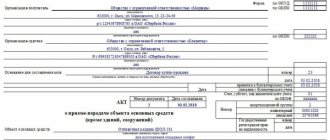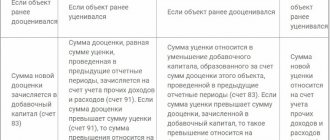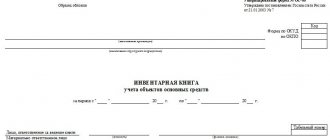Accounting for the movement of inventory items (TMV) at any enterprise has its own characteristics. This is a whole block of costs; not a single company, not a single process in real production, can do without them. This includes many different stocks - the basis that is processed into a product. The lack of orderly movement is dangerous for the normal functioning of the organization; there is a risk of increasing unreasonable expenses and mistakes, which as a result are quite expensive. We advise you to carry out all transactions in a timely manner and record them, so that at the end of the reporting period you do not have to look for expense items.
What is accounting and write-off of inventory items
If you look at accounting standards, the values include the following:
- stored for further resale if the enterprise operates as usual;
- goes into the production process and then sold;
- is in the form of stocks or materials that will be used in the future.
There are 3 categories of this asset - raw materials, products at the time of manufacture and finished. In the first case, these are purchased semi-finished products, materials, structures that are planned to be processed. In the second - unfinished goods that are at the stage of processing, painting or another. The last group consists of items that can be sold as ready for sale. This is reflected in the financial statements in the same sequence.
Inventory and materials are a variety of means and objects of labor that can be used for the needs of the company or for production. They should increase the cost of products. It is one of the most liquid assets after finance. Effective use of this category is no more than 1 year.
They are distinguished by the method of entry. Let's look at how exactly in the table.
| How did you get into the company? | What is taken into account as actual cost |
| Purchased in the standard way for payment | Price of real costs, VAT is not considered:
|
| Created by the company itself | How much was actually spent on production? |
| Presented as a contribution to the management company | The assessment in financial terms, which was agreed upon by the founders, also includes the price of delivery and installation, all expenses for bringing it to a state of use |
| Accepted as a gift, free of charge | Accepted at market value on the day of acceptance in the accounting department, additionally - transportation and installation costs |
| Remained after the main facility was dismantled | |
| Received by barter | Counted as the amount of the asset that was transferred instead of received |
Organization of accounting of material assets in accounting
In this documentation, inventory items are a static indicator. We have already said that it includes everything that is stored as raw materials, and is also currently being produced, and those warehouses in which goods are ready for sale and transportation.
The accountant is obliged to reflect all transactions that occur with these items on the accounts of the enterprise. This is receipt, any movements within the company and write-off due to sale or as a result of damage. Everything must be taken into account and calculated; entries must not be skipped or made approximately, otherwise distortion will begin and questions will arise from the tax office.
Tax accounting of deferred expenses
The Tax Code of the Russian Federation does not separately define the accounting of RBP. It establishes a general rule according to which expenses are related to the taxable base in the period in which they arise under the terms of the transactions concluded.
This means that you need to write off expenses for taxes, guided by the documentary rules according to which the transaction agreement was drawn up. If it follows from them that expenses are distributed over several periods, then for tax purposes they are taken into account during the entire specified time.
For example, an organization paid a certain amount for product certification. This amount is contributed to the tax base in equal shares throughout the entire validity period of the certificate.
FOR YOUR INFORMATION! If it is not possible to determine from the contract the terms to which expenses should be attributed, the organization must do this in accordance with its accounting policies.
RBP and special modes
Not all entrepreneurs deal with deferred expenses. Thus, OSNO payers most often encounter them, and those who choose the “simplified” option, as a rule, do not work with them.
If an organization switched to the simplified tax system from another tax regime, and it still has funds in account 97, they must be completely written off as expenses and reflected in KUDiR. The procedure for their accounting in the field of taxation may differ:
- if they were actually paid before the regime changed to the simplified tax system, they will not reduce the tax base, because they will no longer be included in the reporting period as deductible expenses;
- if these expenses are included in Art. 346.16 of the Tax Code of the Russian Federation and incurred after the transition to the simplified tax system, they can be included in the tax base as part of expenses that reduce it.
Compound
There is a classification in accounting documents; all companies in the Russian Federation operate according to it. In accordance with it, several types of funds can be distinguished:
- spare parts;
- materials for construction;
- raw materials;
- semi-finished products that belong to our own production and are in warehouses;
- purchased and simply finished products;
- lubricants, fuel, some other consumables;
- household equipment for various applications;
- residues useful for the enterprise, returnable part of all waste;
- container
Methods and procedures for keeping records of inventory items (materials and materials)
How exactly you can work with these assets is described in special guidelines number 119. Let's look at the two main subtypes.
Varietal (pros and cons)
Everything is done using cards of the appropriate type. They note the presence of this or that object, their movement and decommissioning.
You can act in any of the following ways:
- Quantitative-sum. It is believed that in this case, they simultaneously count and control changes in numbers and amounts; this is done both in warehouses and in accounting books. The item numbers of all inventory items are used.
- Baldovy. Here they track only quantitative changes by type of value. Accounting uses the sum method with monetary values. Volume tracking is carried out on the basis of primary documentation; for this purpose, card indexes and accounting books are used. Every year after the report, all documents are submitted.
It can be used when storage is carried out by variety and name. At the same time, there is no control over receipts and costs. For each subtype of nomenclature, a card must be created in a strict form. They differ from each other in:
- product brand;
- variety;
- what is it measured in?
- coloring
The created “passports” will be active and valid for 1 year. Everything about the object is included in them, they are registered in a separate register and each one is given a personal number. These processes are carried out by accounting staff. When the first sheet is completely filled, then they write further on the second and so on. Each subsequent sheet is numbered.
This method has noticeable advantages:
- Warehouse space for storage is seriously saved;
- leftovers can be managed quickly.
But there is also a serious drawback: if an enterprise has several types of the same product with different prices, then it will be very difficult to control them.
Party
This type assumes that each batch will be registered and stored separately from the rest. It is used both in warehouse accounting and accounting. For each admission, different documents are created.
These include:
- transported by one vehicle;
- has the same name;
- simultaneously received from a specific supplier.
The received products are registered in the journal and assigned an individual registration number, which will be indicated in the future in the expense statements. Two cards are opened at the same time - one will be used in the accounting department, the second in the warehouse. The forms used are determined by the type of products.
There are several advantages of this type of farming:
- the results of expenditure can be determined without conducting an inventory;
- the safety of inventory items is under increased control;
- The organization's losses are reduced.
But there are also disadvantages:
- warehouses are used irrationally and become cluttered;
- It will not be possible to quickly track changes.
Which one to choose for your company depends on production goals, the size of storage space, the skills of the accountant and the desires of the storekeeper. To quickly decide on a methodology, we advise you to contact specialists, for example, at Cleverence. Our employees will help you find software that will help automate most processes and free up your workforce. Sometimes several installed programs perform the work of an entire department with the press of a couple of keys. If you want to develop, it will be difficult to do so without such software. The Mobile SMART Engineering software product, implemented by , solves logistics problems in the oil and gas sectors, controls the movement of material flows and reduces costs.
How to avoid claims?
To summarize the above, we can state that the current legislation in the field of accounting (budget) does not contain a direct answer to the question: how to take into account a flash card. The Ministry of Finance did not explain this issue either. The analysis of judicial practice and decisions of officials of specific institutions, enshrined in their accounting policies, is contradictory (see, for example, in the Resolution of the Eighteenth Arbitration Court of Appeal dated 08/03/2011 No. 18AP-6963/11, Decision of the Tomsk Region Court of 04/17/2015 . in case No. A67-7469/2014, Decision of the Moscow AS of December 17, 2014 in case No. A40-111746/2014, paragraph 39 of the Order of the Federal Agency for Railway Transport dated December 31, 2014 No. 532 “On approval of the Accounting policies of the Federal Agency for Railway Transport"). Therefore, when deciding whether to account for flash cards as fixed assets or inventories, it is advisable to adhere to the following rules.
Firstly, the decision made by the institution’s commission on the receipt and disposal of assets must be justified. That is, it must contain confirmation of the conclusion made regarding the useful life of flash cards. This may include written guarantees from the manufacturer or supplier, a documentary substantiation of the nature and intensity of use of these media, an analysis of the periods of use for past periods, etc. It is important that the inspectors see that the institution was working on making a decision.
The decision should be fixed in the accounting policy of the institution. In addition, a uniform accounting of flash media arriving at the institution must be organized. In other words, situations should not arise where similar flash cards are taken into account both as part of fixed assets and as part of inventories. _______________________ * unless otherwise provided by the GHS “Fixed Assets”, other regulatory legal acts governing accounting and preparation of accounting (financial) statements.
Rules and methods for accounting for inventory items in an organization
They must be accounted for on special balance sheet accounts through a number of primary documents. When drawing up a balance sheet, they are included in the second section, which is called “Current assets”. You can track changes in it, since balances are entered at the beginning and end of each reporting period.
Inscribed in the reporting, they provide information that accounting work was carried out on them. The dynamics of movement and change are revealed, because their purchases and write-offs are indicated in registers and statements.
The procedure for accounting for material assets in any existing construction organization
All tracking is carried out in accordance with primary documentation, which is compiled exclusively in a pre-approved form.
How to reflect receipt: necessary documents, statements
The following can be accepted for balance:
- raw materials that will be used for creation in the workshop;
- products that await further sale;
- assets if management needs them.
How this will be reflected depends on several parameters:
- where is the acceptance taking place?
- how many goods arrived, in what quality they were;
- to what extent the contract corresponds to the accompanying papers.
What transactions are created upon receipt
If the product came from a supplier, then the following is recorded:
- Dt 10, Kt 60.1 – valuables arrived.
- Dt 19.3 Kt 60.1 – incoming VAT is noted.
In some cases, things come from the founders or other persons. Then they open sub-accounts and keep the following records:
- DT10 KT75.1. Coming from the co-founder.
- DT10 CT 71. From a person on a business trip (accountable).
- DT10 KT20. Creation in the same company.
If the products arrived only for further resale, then 41 accounts will be used.
How to store it all
They do not always label only purchased materials. Sometimes they even reflect something that does not belong to the organization. This happens when something was put into safekeeping or was created as a result of dismantling at the customer’s place. In this case, everything is accumulated on off-balance sheet 002, indicating the circumstances of occurrence, price and period.
Movement of goods and materials within the company: documents, postings
The cycle of an item is not always acceptance and disposal. Sometimes he moves from one warehouse to another, goes to a branch or returns to the central premises. The transfer of raw materials to the production floor also refers to this part of the product's life. An invoice is prepared.
When is it relevant:
- what is produced will be used by the enterprise;
- return object;
- production waste or defective parts are handed over.
How to write off
The last, necessary part of the life cycle of assets. It is important to ensure that the actual quantity always matches the one recorded in the accounting department. An act is drawn up for disposal. Everything that is indicated in it cannot be subject to further application. All parameters are entered - weight, number, reason for write-off.
The accountant's task is to reflect the value of what will be removed from the balance sheet. You can calculate by:
- average cost;
- the price of an individual object;
- FIFO.
Postings
There are three options in which the score in Dt is set as 20, 23 or 25, and in Kt there will always be 10.
Disposal of inventory items: documents, postings
Withdrawal from balance is a normal workflow, since nothing can be used indefinitely. They are regularly sent for processing, sale or write-off. Each release from the pantry is processed separately, with different accounting documentation. If these are limited materials, then there is a limit card; if there are no consumption standards, then the requirement is an invoice. For sales - invoice according to f. No. 15, like a vacation on the side.
Amortization of intangible assets
Amortization of intangible assets generates accounting and tax expenses. An incorrect amount of depreciation of intangible assets leads to tax arrears and unreliable reporting. Check your intangible assets.
Read in the article:
Intangible assets are intangible objects, most often rights, without a limit on value and with a service life of more than 12 months, if their owner:
- Intends to use intangible assets:
- in the production of products, works, services;
- when selling goods;
- for management purposes;
- for other businesses.
- Has documents confirming the existence of the object - evidence of exclusive, licensed rights or other documents, for example:
- patent;
- certificate for the object of individualization, etc.
- Can reliably estimate the cost of intangible assets.
- Has the right to benefits from the exploitation of an intangible asset.
- Doesn't intend to sell the property.
Try calculating depreciation of intangible assets online.
Most often, intangible assets include intellectual property, named in the Civil Code of the Russian Federation. Read about it in Table 1.
Table 1.
Intangible assets in accounting and tax accounting
| NMA | Tax accounting | Accounting |
Right to:
| Yes | Yes |
| The right to a computer program, a database | Yes | Yes |
| Right to chip topology | Yes | Yes |
Right to the object of individualization:
| Yes | Yes |
| Right selection results | Yes | Yes |
| The right to works of science, literature, art, audiovisual works, phonograms, etc. | Yes | Yes |
| Right to know-how | Yes | Yes |
| Business reputation of the company | No | Yes |
- Download a reference book on the composition of intangible materials.
As for rights to other similar objects that are not related to intellectual property, they can be reflected in accounting as intangible assets only if:
- The owner has documents about:
- the existence of an object;
- belonging of the object to the owner.
- Access of other persons to use the facility is limited.
For which intangible assets is depreciation not accrued?
Accrual of depreciation of intangible assets is prohibited in two cases.
Case 1.
For objects without a specified service life.
With any method of depreciation, it is accrued over the period of use of the object for production, management or other business purposes.
But for some intangible assets it is impossible to determine the useful life. This could be, for example, a movie, a logo, a literary work, etc.
If the service life is indefinite, the monthly depreciation amount cannot be calculated and expenses cannot be recognized.
It is not profitable for the owner of intangible assets to “lose” expenses, and in addition, it is possible that after some time he will be able to decide on the period of use of the object. Therefore, PBU 14/2007 establishes a mandatory annual review of the situation and identification of the possibility of determining the useful life of an intangible asset. After this, depreciation of intangible assets is allowed to be calculated.
Case 2.
According to intangible assets of non-profit legal entities.
Amortization of intangible assets in accounting
The cost of intangible assets is written off as accounting expenses through depreciation - that is, the costs of purchase, production, receipt, other receipt, registration, etc. In order to correctly calculate depreciation, you must first correctly determine the value of the intangible asset, including all allowed costs. Read about this in Table 2.
Table 2.
Amortization of intangible assets in accounting
| Expenses | Purchase of intangible assets | Creation of intangible assets |
| Contract price of the object | Yes | Yes |
| Customs duties | Yes | Yes |
| Customs duties | Yes | Yes |
| Patent fees | Yes | Yes |
| Non-refundable VAT | Yes | Yes |
| Cost of information services and consultations | Yes | Yes |
| Remuneration to the intermediary | Yes | Yes |
| Other costs in connection with the purchase | Yes | No |
| Remuneration for contractors | No | Yes |
| Remuneration for authors | No | Yes |
| R&D fee | No | Yes |
| Employee salaries | No | Yes |
| Mandatory contributions from employee salaries | No | Yes |
| Depreciation of fixed assets and other intangible assets | No | Yes |
| and equipment repair | No | Yes |
| Other costs for creating intangible assets | No | Yes |
| Refundable VAT | No | No |
| Interest on loans and credits | No, except for investment intangible assets | No, except for investment intangible assets |
| R&D costs of previous years | No, if they are included in other expenses | No, if they are included in other expenses |
| General expenses | Yes, if they relate to the purchase of intangible assets | Yes, if they relate to the creation of intangible assets |
Example 1
Amortization of intangible assets in accounting
Symbol LLC, operating at OSN, acquired the exclusive right to the trademark, paying for:
- consultations – 90,000 rub. (without VAT);
- remuneration to the copyright holder - 354,000 rubles, including VAT 54,000 rubles;
- daily allowance for the seconded employee who conducted the negotiations - 6,000 rubles.
Depreciation of intangible asset “Symbol” will be calculated from the cost of 396,000 rubles. (90,000 rub. + 354,000 rub. – 54,000 rub. + 6,000 rub.).
How is depreciation calculated on intangible assets?
Depreciation write-off of the value of intangible assets begins from the next month after the object is reflected in account 04 “Intangible assets”. During the operation of the facility, it is depreciated every month, regardless of the profitability or unprofitability of the business. Depreciation recognition of expenses ends from the next month after the object:
- deregistered (for example, due to disposal);
- completely cushioned.
Methods for calculating amortization of intangible assets
There are only three ways in accounting:
Method 1.
Linear.
Example 2
Depreciation of intangible assets in accounting
Let's continue example 1 and assume that the service life of the trademark is 11 years, that is, 132 months. The Symbol accountant determined the monthly linear write-off in the amount of 3,000 rubles. (RUB 396,000 / 132 months).
Method 2.
Reducing balance.
Example 3
Methods for calculating amortization of intangible assets
Let's add the condition of example 2. Let's assume that Symbol writes off the cost of intangible assets using the reducing balance method with a coefficient of 2. Depreciation amounts for the first three months of ownership of the trademark are shown in the table.
| Period | Remaining term in months | Remaining value of intangible assets at the beginning of the month | Depreciation amount | Remaining value of intangible assets at the end of the month |
| 1 month | 132 | 396,000 rub. | 6000 rub. | RUB 390,000 |
| 2 month | 131 | RUB 390,000 | 5954 rub. | RUB 384,046 |
| 3 month | 130 | RUB 384,046 | 5908 rub. | RUB 378,138 |
Method 3.
Proportional to sales volume.
Example 4
How is depreciation calculated on intangible assets?
Let's take the condition of example 2 as a basis and assume that Symbol writes off the cost of intangible assets in a proportional manner, setting the sales volume using the trademark at 500,000 units. Depreciation amounts for the first three months of trademark ownership are shown in the table.
| Period | Sales per month | Depreciation amount |
| 1 month | 5000 units | 3960 rub. |
| 2 month | 10,000 units | 7920 rub. |
| 3 month | 30,000 units | RUB 23,760 |
Depreciation amounts should be reflected in a special “primary” statement:
- statements.
- statements.
Calculation of depreciation of intangible assets
The written-off value of intangible assets is reflected in account 05, and the correspondence of accounts depends on the direction of use of the object. Read about this in Table 3.
Table 3.
Calculation of depreciation of intangible assets
| Dt | CT | Type of use of intangible assets |
| 20 (23, …) | 05 | In the production of products, works, services |
| 26 | 05 | For management purposes |
| 44 | 05 | When selling goods |
| 08 | 05 | To create a fixed asset or other intangible asset |
| 91-2 | 05 | To transfer non-exclusive rights to other persons |
Example 5
Calculation of depreciation of intangible assets
In the situation from example 2, the Symbol accountant reflects the transaction every month:
Debit 44 Credit 05
– 3000 rub. - monthly write-off.
And in the situation from example 3, if “Symbol” temporarily transferred the right to use the trademark to another, it reflects a write-off in account 91-2:
Debit 91-2 Credit 05
– 6000 rub. – write-off of the cost of intangible assets in the first month.
Source: https://www.BuhSoft.ru/article/1329-amortizatsiya-nematerialnyh-aktivov
Problems with accounting and control of inventory items
When working with assets, some difficulties may arise related to the regrouping of costs, re-grading, untimely appearance of papers or the formation of balances. Let's look at these issues in more detail.
“Re-grading” of raw materials and type of measurement during write-off
One of the important difficulties that usually arises due to the inattention of the person in charge or in the case when the form submitted for deletion lists an item that is not among those recorded. This is due to:
- incorrectly inserted card;
- entered different units at the time of entry and deregistration;
- outdated names used by foremen;
- incorrect quantity in stock.
"Redden" residues after they were written off for production
The presence of a negative balance indicates that errors were made during inventory or work. In some cases, the accounting department simply has not yet received the remaining papers in which the missing amount can be delivered to the receipt. To avoid this complexity, accounting can be divided into management and accounting.
Delay in documentation from suppliers
If you do not control the document flow, the accountant will not know when, in what quantity and from whom the materials arrived. Therefore, he will not know what to demand from the procurement department. As a result:
- it will be difficult to write off raw materials that have not yet been delivered to the receipt;
- accounts payable information will be inadequate;
- Compiling reconciliation acts and reporting will be quite problematic.









